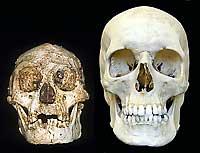Fossil Records: Big Lizards, Little People and Small Elephants
This is very very cool. I read about it in
today's Seattle Times and it's something that will stir the evolutionary pot for some years to come.
bq.
Discovery of prehistoric "little people" creates huge stir in scientific world
Scientists have discovered a tiny species of ancient human that lived 18,000 years ago on an isolated island east of the Java Sea — a prehistoric hunter in a "lost world" of giant lizards and miniature elephants.
And why the shift in stature (they were about three feet tall)?
bq. Researchers suspect that the earlier ancestor may have migrated to the island and evolved into a smaller dwarf species as it adapted to the island's limited resources. This phenomenon, known as the "island rule," is common in the animal world but had never been seen in human evolution.
bq. "Not even in primates," said paleoanthropologist Peter Brown of Australia's University of New England, a member of the multinational team reporting on the find today in the journal Nature. "But even though we have evidence of intelligence [in the new species], they were clearly subject to isolation and dwarfing."
The article then goes on to talk about the Wallace Line:
bq. The new find is certain to influence a flourishing debate over the human presence both in Indonesia and on Flores, which lies immediately east of the so-called "Wallace Line" dividing those islands once connected to Australia or Asia, and those, like Flores, surrounded by water for the past 2.6 million years.
bq. Generally speaking, islands west of the Wallace line, such as Java, display a full range of mainland animals. On the isolated, ecologically limited eastern islands, however, animals often evolved in conformity with the island rule: Animals smaller than rabbits get larger; animals larger than rabbits get smaller.
bq. Flores, with a limited food supply and no predators, was a prime example of this mechanism. At the time when the Flores woman lived, the island hosted both Komodo dragon lizards 3 feet long and a dwarf variation of stegodon, a prehistoric elephant.
Here's her skull compared to a modern Homo Sap:

A capsule biography of Alfred Russel Wallace can be found
here
His
home page is here (not to shabby considering he died in 1913)
More on the Wallace Line can be found
here.
There are
lots of books available about him -- both his works and biographies (he was a contemporary of Charles Darwin and it was his work in parallel with Darwin's which sparked Darwin to get off his butt and publish his "Origin" -- Wallace had the same data and was writing to Darwin asking for thoughts on the book he was about to publish while Darwin had been sitting on his notes for a couple of years).
Finally a Wallace quote which should be taken to heart by today's crop of environmentalists:
bq. "It has been generally the custom of writers on natural history to take the habits and instincts of animals as the fixed point, and to consider their structure and organization as specially adapted to be in accordance with them. But this seems quite an arbitrary assumption, and has the bad effect of stifling inquiry into those peculiarities which are generally classed as 'instincts' and considered as incomprehensible, but which a little consideration of the structure of the species in question, and the peculiar physical conditions by which it is surrounded, would show to be the inevitable and logical result of such structure and conditions.
From 'The Ornithology of Northern Celebes,' 1860, Ibis 2: 140-147, on pages 145-146
Fascinating stuff. I was a Biology major in a past life and Wallace is finally getting his recognition as one of the tall dogs of evolution and natural science.
Posted by DaveH at October 28, 2004 8:57 PM
